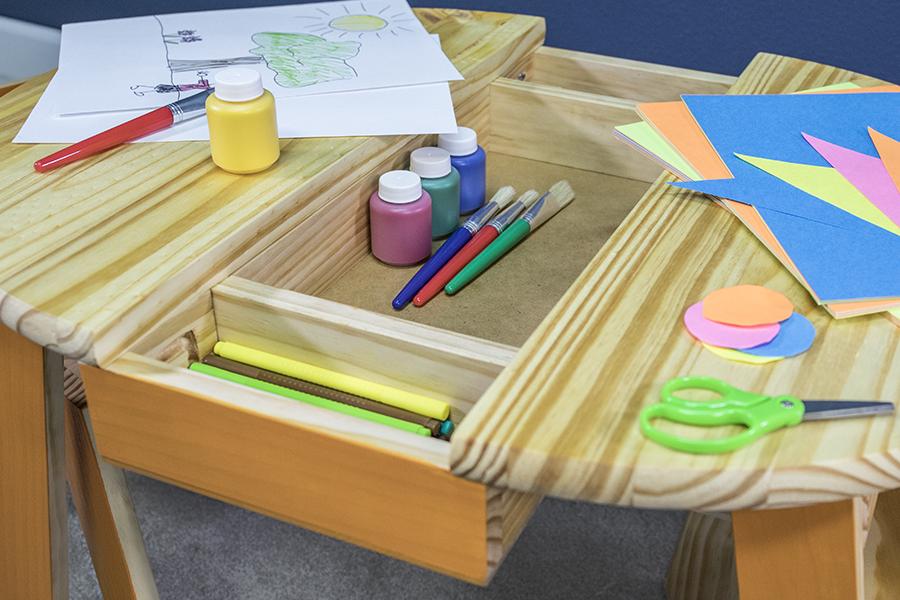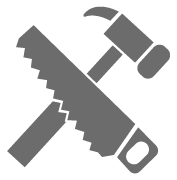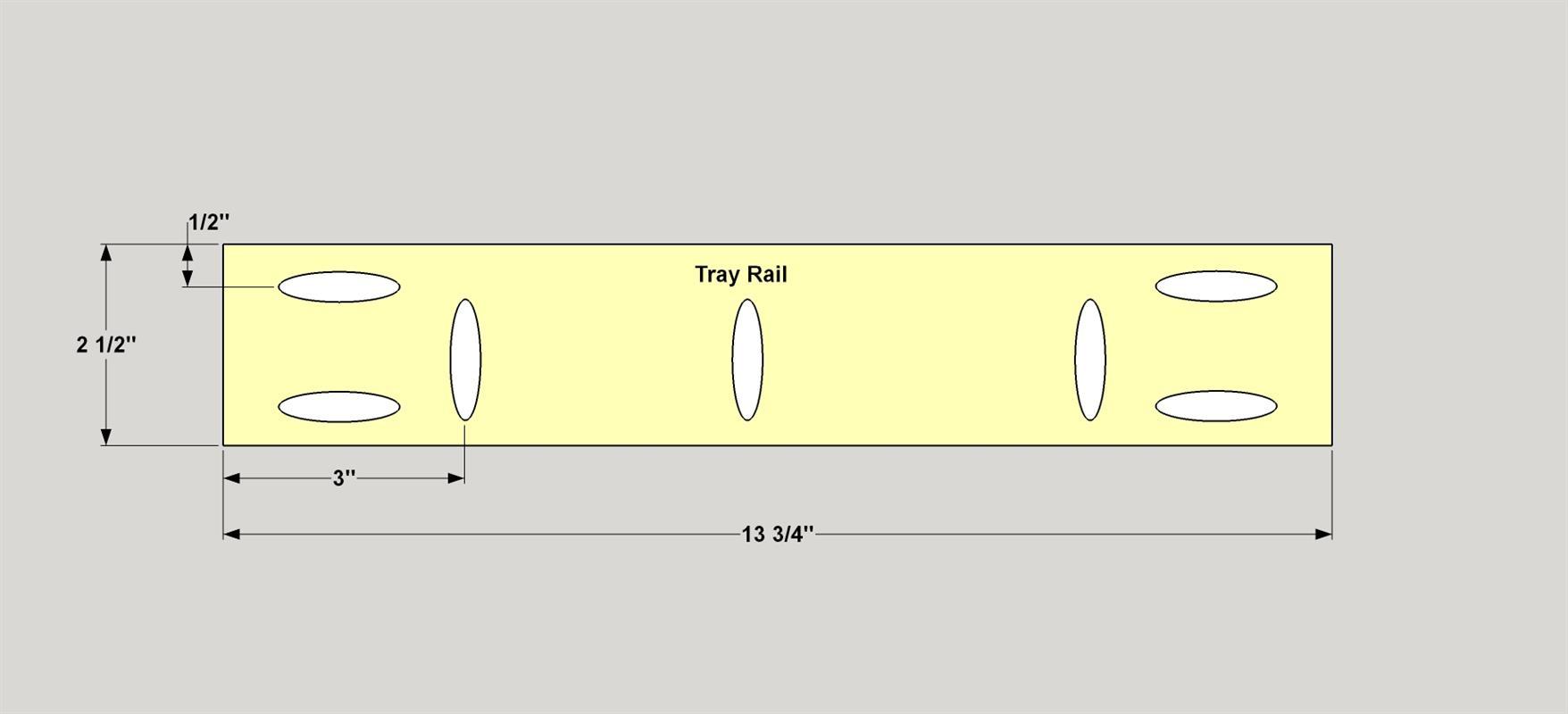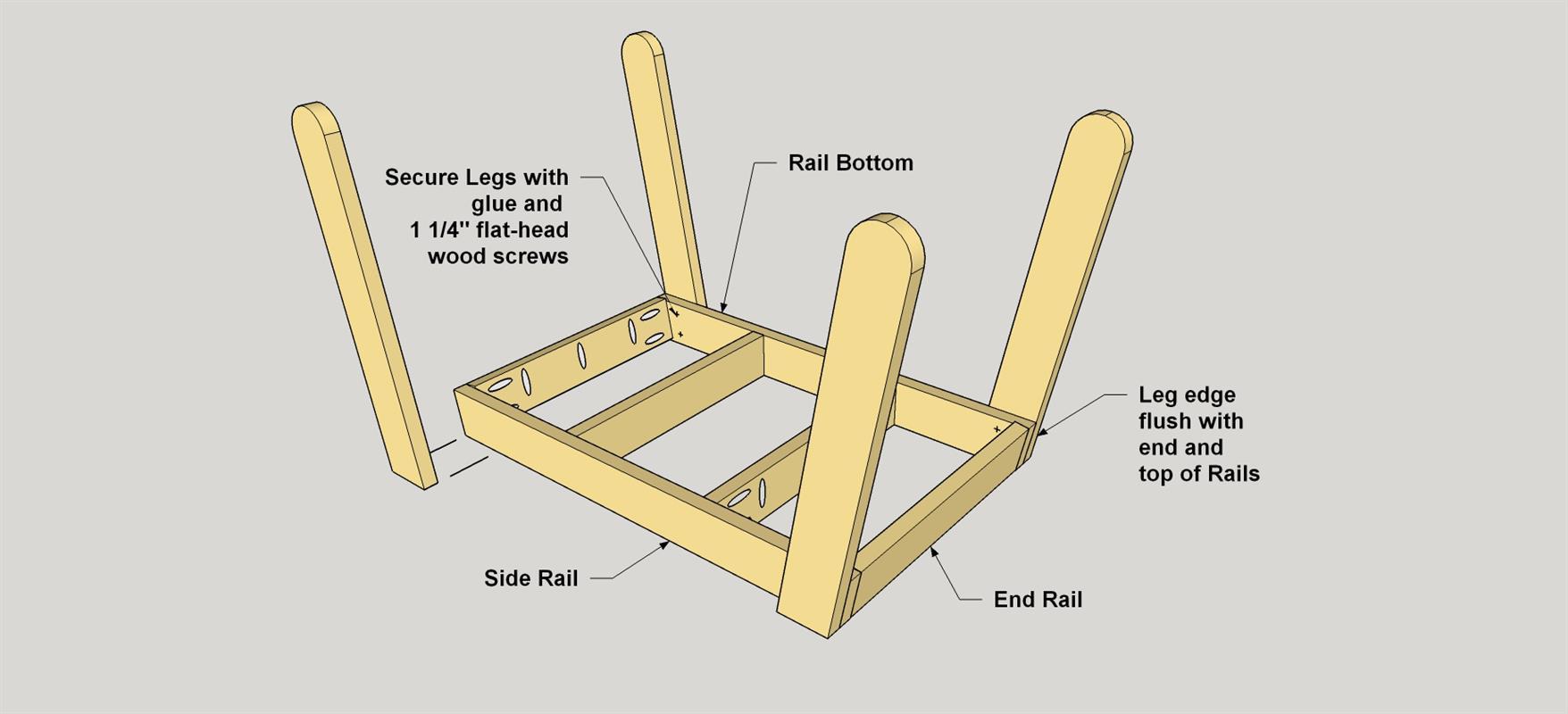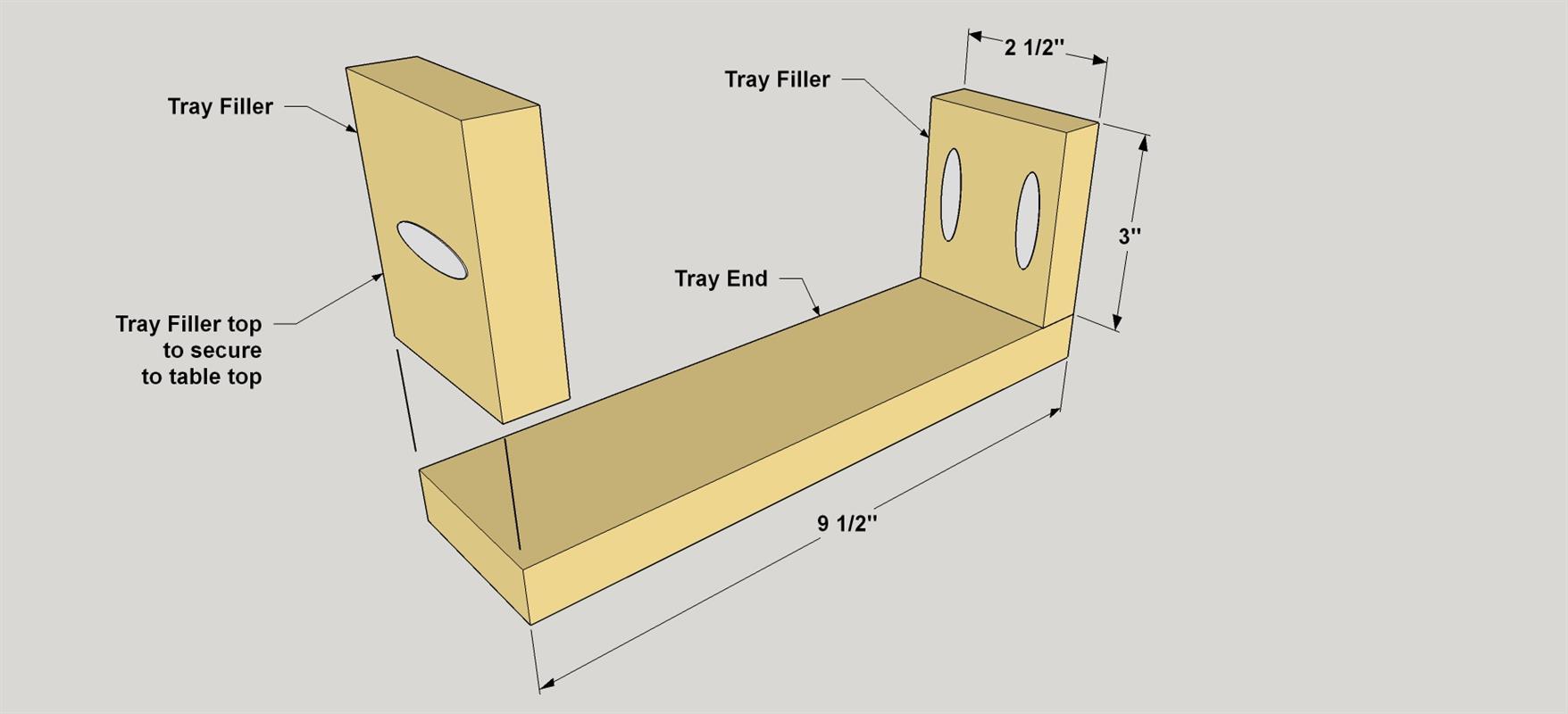Kids’ Art Table and Chairs
By Kreg ToolThis pint-sized art table will help bring out the artist in any child. It features work and storage space, plus a pair of chairs that are sized just right for small kids. Using a pre-made round top keeps the table simple, while a few angles and gentle curves add an extra touch of style.
Directions
-
Make the Side Rails
Cut two Side Rails to length from 1x3 boards, as shown in the cut diagram. Cut opposing 10° angles on the end of each Side Rail as shown. Drill four pilot holes in each piece at the locations shown. These will be used to attach the Legs in a later step.
-
Make the End Rails
Cut Two End Rails to length from 1x3 boards, as shown in the cutting diagram. Set your pocket-hole jig for 3/4"-thick material, and then drill pocket holes at the locations shown.
-
Make the Tray Rails
Cut two Tray Rails to length from 1x3 boards, as shown in the cut diagram. Drill pocket holes at the locations shown. With these pieces cut, sand the faces smooth, and sand the edges to soften the sharp corners.
-
Build the Frame
Now attach the two End Rails to one Side Rail so that the face of each End Rail is flush with each end of the Side Rail. Make sure the pocket holes that will be used to attach the table Top later are oriented so the face down toward the work surface Secure the pieces with 1 1/4" coarse-thread pocket-hole screws. Next, position the two Tray Rails against the Side Rail at the locations shown. Again make sure that the pocket holes face downward, and secure these pieces with 1 1/4" coarse-thread pocket-hole screws. Finally, add the second Side Rail and attach it to the Rails in the same manner.
-
Make the Legs
Cut four Legs to length from 1x3 boards as shown in the cut diagram. Cut a 10° angle on one end of each Leg. Next, on one of the legs, lay out the radius on the opposite end, and then cut it out with a jigsaw. Sand the curve smooth. Use this Leg as a pattern to lay out the other three Legs, and then cut and sand each one. Sand the face smooth and ease the edges.
-
Attach the Legs to the Frame
Lay the frame assembly face down on a work surface. Then glue and clamp the Legs to the Side Rails at the positions shown. Make sure the edge and top of the Legs are flush with the edge and top of the Side Rails. Secure the Legs to the Side Rails using 1 1/4" flat-head wood screws.
-
Make the Tray Fillers
Cut four Tray Fillers to length from 1x3 boards, as shown in the cut diagram. On one side of each Filler, drill a single pocket hole at the location shown on the outside face. Then drill two pocket holes on the inside face of each Filler at the locations shown. Sand the Tray Fillers.
-
Build the Tray Ends
Cut two Tray Ends to length, as shown in the cutting diagram, and then sand them smooth. Now glue and clamp two Tray Fillers to one Tray End as shown. Make sure the single pocket-hole side faces outward and that both Fillers are oriented with the pocket holes facing in the same direction.
-
Attach the Tray Ends to the Frame
With the table base standing upright, glue and clamp the tray end assemblies to the Side Rails at the locations shown. Make sure the pocket holes that will be used to attach the Top later are facing in the correct direction (upward). The glue just holds the assemblies in place temporarily. They’ll get screwed to the Tray Bottom and to the table top later. Let the glue dry before you remove the clamps.
-
Make the Tray Bottom
Cut the Tray Bottom to size from a sheet of 1/4" hardboard, as shown in the cut diagram. Mark the location of the pilot holes and then drill each one with a 1/8" bit. These will be used to attach the Tray Bottom.
-
Install the Tray Bottom
Apply glue along the bottom edge of the Tray Rails and Ends. Then lay the Bottom in position, and secure using 3/4" pan-head screws.
-
Cut the Top
Divide the round panel into two equal parts and draw a guideline. Cut the round in half with a circular saw and then sand any rough edges smooth.
-
Attach the Top
Lay the Top on a flat work surface with the best face down. Lay the table base on the top and align the parts so the straight edges of the Top are flush with the inner edges of the Tray Rails, as shown. Also make sure that the top overhangs equally on each side. Secure the Top to the table base by driving 1 1/4" coarse-thread pocket-hole screws at the locations shown.
-
Apply a Finish
With the table complete, you can do any needed final sanding, and then apply finish and paint. We painted the outside faces of the table base, and applied an oil finish to the rest of the table. If you’re also building chairs, you can leave those steps until you’re done building the chairs
-
Review Chair Materials and Parts
If you’re planning to add chairs, you’ll want to note that the materials list and cutting diagram are for one chair. To build two, double the number of boards and screws, and make twice as many of each part.
-
Make the Chair Legs
Cut four Legs to length from 1x3 boards, as shown in the cut diagram. Cut a 10° angle on one end of each Leg. Next, on one of the legs, lay out the radius on the opposite end, and then cut it out with a jigsaw. Sand the curve smooth. Use this Leg as a pattern to lay out the other three Legs, and then cut and sand each one. Sand the face smooth and ease the edges.
-
Make the Leg Rails
Cut two Leg Rails to length from 1x3 boards, as shown in the cut diagram. Cut opposing 10° angles on each end of each board, as shown. Set your pocket-hole jig for 3/4"-thick material, and then drill pocket holes at the locations shown. Make sure the pocket holes are perpendicular to the ends of the boards. After you drill the pocket holes, sand the Leg Rails.
-
Create Chair Side Assemblies
On a flat surface, align two Legs to one Leg Rail so the top of the Legs are flush with the top of the Leg Rail. Add glue and secure the assembly with 1 1/4" coarse-thread pocket-hole screws. Repeat this operation for the second side.
-
Make a Seat Rail
Cut one Seat Rail to length from a 1x3 board, as shown in the cut diagram. Drill pocket holes at the locations shown. Then sand the Seat Rail.
-
Attach the Seat Rail
Inset the edge of the Seat Rail 1/8" from the top edge of the Leg and align it so it is perpendicular to the top edge of the Leg. Secure the Seat Rail to the Leg using 1 1/4" coarse-thread pocket-hole screws.
-
Make the Seat Slats
Cut two Seat Slats to length from 1x6 boards, as shown in the cutting diagram. Drill six pocket holes in one Seat Slat and five pocket holes in second Seat Slat, as shown in the Illustration. Then Sand the Slats smooth, bit don’t sand the edges.
-
Attach the Seat Slats
Position the first Seat Slat against the Seat Rail and secure it to the chair side assembly and to the Seat Rail using 1 1/4" coarse-thread pocket-hole screws. Set the second Seat Slat behind the first, and secure it to the chair side assembly and the first Slat using1 1/4" coarse-thread pocket-hole screws.
-
Make the Seat Back
Cut one Seat Back to length from a 1x8 board, as shown in the cut diagram. Lay out the radiused corners, and then cut them out with a jigsaw. Sand the edges smooth. Next, drill pocket holes at the locations shown. Then sand the Seat back and ease the edges.
-
Attach the Seat Back
Cut a 10° angle on one end of a scrap block. Set the Seat Back in position at the location shown. Clamp the block in position to support the angle of the Seat Back and then secure the Back to the Leg using 1 1/4" coarse-thread pocket-hole screws. Secure the rear Seat Slat to the Seat Back with a single pocket-hole screw.
-
Add the Second Side
Set the chair assembly on a work surface so it rests on its seat. Position the second chair side assembly in place so it matches the first, and then secure it using 1 1/4" coarse-thread pocket-hole screws.
-
Apply a Finish
With the chair complete, you can do any final sanding that’s needed, and then apply paint or finish. We painted the outside faces of the chair sides, and applied an oil finish to the rest of the chair.





